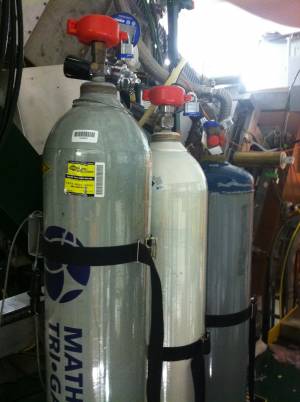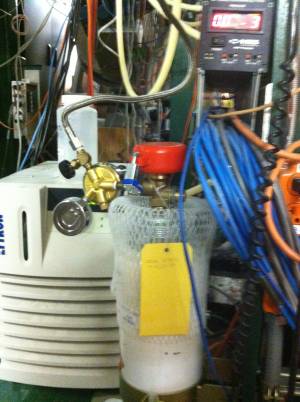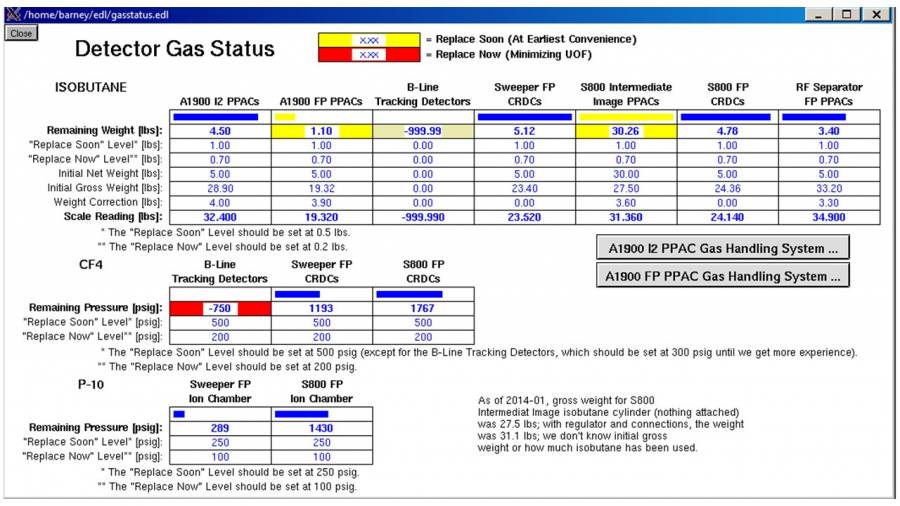Table of Contents
Detector gas handling system
General Information for gas handling systems
The gas handling systems for the gaseous detectors in both intermediate-image and focal-plane boxes are operated remotely through CS studio. Their pages can be found on the EXP network through FRIB EXP Main → S800 → GHS Pages (Secondary Pages). Detailed instructions are found in the following pages:
Preparation of Gas bottles for filling of focal-plane detectors
In Data-U4
- Ensure RBT_BTS34:GV_D2671 (formerly I265GV) is closed (in CS Studio) to isolate focal plane vacuum chamber from the rest of the beamline
- Confirm that the focal plane chamber is under vacuum
In the S3 vault
- Ensure that the gas handling system roughing pump is running and has a good vacuum
- The pump sits on the floor under the focal plane behind the south support post
- The display unit for the pressure at the pump has a needle indicator and is mounted under the focal plane on the south support post
- Ensure that the main valves on the gas bottles are open (see pictures below)
- Open valves downstream of regulators in each bottle
- Ensure that the gas bottles are not empty
- The gas regulators are not normally adjusted. They should all be set to provide a pressure around 20 psi
- The bottle supplying the P-10 gas for the ionization chamber is secured to the cross-brace of the south support for the focal plane chamber. It has an electronic Ashcroft pressure gauge upstream of the regulator (toggle on and off with the “on/off” switch) and a mechanical pressure gauge downstream of the regulator
- The bottle supplying CF4 (tetrafluoromethane) gas for the CRDCs is secured to the cross-brace of the south support for the focal plane chamber. It has an electronic Ashcroft pressure gauge upstream of the regulator (toggle on and off with the “on/off” switch) and a mechanical pressure gauge downstream of the regulator
- The bottle supplying isobutane (C4H10) for the CRDCs is secured to the south support post for the focal plane chamber. It sits on a scale for monitoring the isobutane consumption – the electronic display for the scale sits on the chiller unit under the focal plane chamber. It has a mechanical pressure gauge downstream of the regulator
Tracking Gas bottles pressures
A rather conservative rule of thumb that helps estimate how much gas will be consumed during the course of an experiment assumes that when the detectors are filled and with gas running through them, the S800 IC detector consumes ~10 psi/day of P10, and the CRDCs consume ~10 psi/day of CF4 and ~0.07 lb/day of Isobutane. The process of filling the detectors, is approximately equivalent to 1 day of gas consumption during normal operations.
In order to track the status of the gas bottles for the ionization chamber, the CRDCs, and the TPPAC, it is possible to monitor their remaining pressures from Barney. Just open the A1900 page, then Tools, and then Gas Status. The following window will be displayed:
The gas content of each bottle is tracked by measuring the pressure in regulators (e.g. P10 and CF4) or the weight of the bottle on a scale. Both types of measured values are encoded in EPICS PVs, allowing remote monitoring of the gas available. There are two alarm levels (low alarm and high alarm) that can be adjusted using the corresponding EPICS PV. For instance, for the isobutane bottles (5 lb net weight), the low- and high-level alarms trigger at 1 lb and 0.5 lb, respectively.
When installing a full bottle in a scale (e.g. isobutane), it is important to follow a procedure to account for the differences between the weight measured by the scale, and the actual gross weight. After removing an empty bottle, proceed as follows:
Adjusting the pressured reading from a scale (for instance isobutane) requires some special guidelines. In the case of isobutane, the following EPICs PVs are involved:
- Check the weight marked in the scale when it is empty (no bottle). If different than zero, press “set zero” and ensure that it marks 0 lb
- Check the gross and net weight in the bottle (as seen in the labels)
- Install the bottle in the scale and check its weight.
- Update the following EPICS PVs with the correct values:
- I265DGWN: net weight, as marked in the bottle (e.g. 5 lb)
- I265DGWG: gross weight, as marked in the bottle (e.g. 41.6 lb)
- I265DGWS: weight, as read from the scale
- I265DGWC: correction factor used to match the scale weight and gross weight when the full bottle is installed.
- I265DGW: net weight deduced from the scale
Replacing Gas bottles
In preparation


